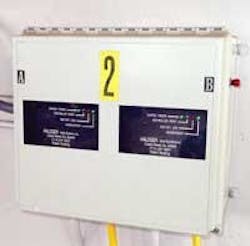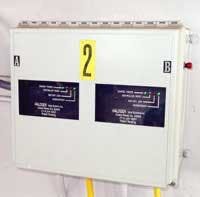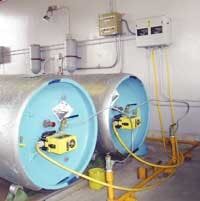Emergency Preparedness Pays Off During Chlorine Leak
By Gerald F. Connell
Routine testing of emergency shutoff valves for chlorine ton containers paid off recently for a southern California water treatment plant when a newly installed container began leaking.
Water treatment plant safety equipment should be tested or used in training exercises on a periodic basis — daily, weekly, monthly — depending on the style of equipment, availability and manufacturer's instructions. Periodic testing of safety equipment is necessary to ensure its operation when needed.
Depending upon the type of equipment, testing may require a visual inspection, operation of a bell, siren or horn, closure of an emergency valve, replacement of perishables (e.g. chemicals) to maintain their shelf life, or training in the use of equipment such as gas masks, emergency kits or gas detectors.
The California plant asked that its name not be used because of security concerns. The 140 mgd facility has a conventional water treatment plant design with rapid mix, flocculation, settling, filtration, disinfection and storage. In the rapid mix stage, potassium permanganate is added for odor control, ferric chloride is added as the primary coagulant and an organic polymer is used as a secondary coagulant. Lime is also added for pH control. Chlorine gas is added to the raw water at the rapid mix stage to enhance plant performance and at the settled water channel prior to filtration to insure a finished water chlorine residual of 2.7 mg/L. Chlorine can be added at other locations as required.
Disinfection Facility
Chlorine is supplied in one ton containers. There are two containers on standby and two on-line. Liquid chlorine is fed from the lower of the two valves on each ton container through a liquid manifold to chlorine vaporizers where chlorine liquid is converted to gas. The gas is piped to four gas feeders (chlorinators); two of which are in operation and two on standby. A chlorine solution is then added to the water at the three points of application. Plant water flow rates and chlorine residual signals are sent to a central control room for monitoring purposes. The chlorinators are adjusted manually to maintain a chlorine residual of 2.7 mg/L at the plant effluent.
The ton containers are stored on trunnions with rollers that facilitate rotation of the containers in the event of a leak. Each ton container is connected with a flexible connector to a liquid manifold. This arrangement is standard industry practice for tons that are in use or on standby. Uniform Fire Code requirements call for containment for one full container in the feed room. Containment to meet the Fire Code is facilitated by using Automatic Valve Operators (AVOs).
Each AVO is mounted directly to a liquid valve on each of the ton containers. The all-electric Eclipse® AVO, supplied by Halogen Valve Systems, is battery powered and recharged by standard line voltage (115 or 230 vAC, 50/60Hz). Automatic operators respond to an external signal such as that supplied by a chlorine gas detector, a fire alarm, an earthquake sensor or a remote manual contact. The signal closes the open ton valves. Eclipse® AVOs are mounted directly to the liquid or gas feed valve on the ton container and do not interfere with manual valve operation or piping system connections.
Halogen's Automatic Valve Operators have also been used on compressed gas (liquid) containers of sulfur dioxide and anhydrous hydrogen chloride. The valve operators can be installed directly on the valves of other types of chlorine containers such as 150-pound cylinders.
To alert plant personnel of a chlorine leak, the storage and use rooms are equipped with quantitative chlorine gas detectors. Four gas detectors are in the storage room and three are in the feed room. Multiple detectors are used to verify gas leaks and ensure a high confidence level in the signal sent to the control room. An alarm sounds at the plant and the control room to alert operating personnel of a situation requiring investigation and corrective action.
Response of the gas detector is checked monthly with a chlorine solution and the sensor is sent back to the supplier annually for checkup and recalibration. Plant personnel test each automatic valve operator monthly or during the changing of containers.
Chlorine Incident
Recently an emergency alarm occurred that showed the value of the automatic valve operators and the importance of testing. During operation, the chlorine ton container feed system had switched automatically from two empty containers to two standby containers. The now empty containers needed to be replaced. The operator removed the empty tons with the lifting beam and hoist. New, full tons were installed, the flex connectors mounted and the valve operators connected. Following prescribed procedures, operating personnel tested the performance of the two valve operators on the containers. The two new tons were left in the standby mode with valves open. This allows the switchback to the two new standby tons when the currently operating tons became empty.
Operating personnel left the room and were about to go to other portions of the plant when the gas detector alarm sounded. When an alarm sounds indicating a chlorine leak, plant procedure requires that the valves be closed from a manual switch mounted outside the building or in the plant control room. Operating personnel confirmed the leak and activated the valve operators to shut the valves on each of the four-ton containers.
Since the operators were outside the building, a quick observation of a greenish cloud indicated the presence of chlorine in the room. The amount of chlorine leaked into the room was estimated at 16 fluid ounces. The maximum concentration in the room, assuming a homogeneous mixture, was well over 100 ppm. The gas detector alarm set point is at 0.5 ppm. Each of the four gas detectors had reached maximum regardless of their location relative to the source of chlorine. An estimated 2 to 3 seconds was needed for vaporization and gas detection and the valve closure was completed in less than 3 seconds. The entire incident was over in less than 10 seconds.
When the valves were shut down and the area cleared, plant personnel donned self-contained breathing apparatus and protective clothing. On entering the room it was determined that the recently made connection to the new, standby container had leaked. Once the gasket was replaced and the connection tightened, the system was checked for chlorine leakage with an ammonia vapor solution. No white cloud formed that would indicate a leaking connection. The chlorine containers were placed back in service.
Analysis
An inspection clearly identified that the leak occurred at the new connection. There was no other source. The immediate availability of plant personnel who activated the automatic valve operator was important. Quick action averted a disaster since all open valves were connected to the same liquid manifold.
Instead of the estimated 16 ounces, 2 tons of chlorine could have escaped to the atmosphere and the room. With this quantity of gas present in the atmosphere, it is quite probable that the entire plant and surrounding community would have been evacuated.
About the Author: Gerald F. Connell is an independent consultant with over 35 years in the use and handling of chlorine in water treatment. He is the author of "The Chlorination/Chloramination Handbook" and the recently published "The Chlorination/Dechlorination Handbook."


